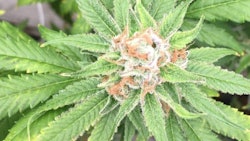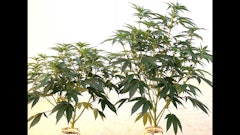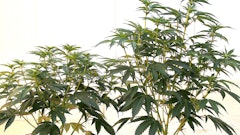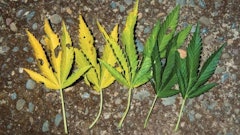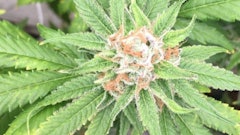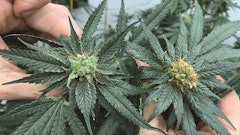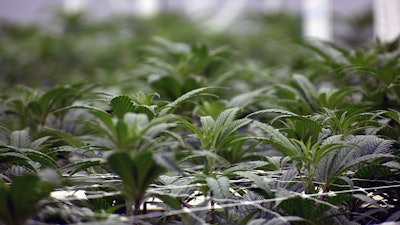
Hop latent viroid has made its way to Vermont, where the state’s Cannabis Control Board (CCB) confirmed its presence at a tier 1 cannabis cultivation site—the smallest of six license types with a max canopy size of 1,000 square feet.
Also referred to as “dudding” or “dudders” disease, hop latent viroid (HpLVd) is a highly contagious plant pathogen responsible for stunted growth, underdeveloped trichomes and diminished cannabinoid content, notably THC potency.
Physical symptoms of the viroid can be difficult to detect during the earlier stages of growth—unless a grower is specifically measuring root development—and often go unnoticed until final yields are weighed.
“Often, the disease is not diagnosed until harvest and potency testing—[HpLVd]-positive cannabis may contain roughly half the THC of healthy plants,” according to a Vermont CCB press release. “Limited published research exists, but [the viroid] does not appear to be airborne and does not have any known impacts to human health.”
Although HpLVd infection can affect different cannabis genotypes to varying degrees, fresh flower weights typically experience reductions in the range of 20% to 25% on final yields, according to Zamir Punja, Ph.D., a professor of plant pathology and biotechnology at Simon Fraser University in British Columbia, Canada.
Dried flower can face a 30% to 50% reduction in cannabinoid content, while terpenes can be down by about 10%, Punja recently told Cannabis Business Times. And trichome heads appear collapsed on diseased plants, almost like a hot air balloon that is only half filled, which is likely why terpenes and cannabinoids have reduced content, he said.
Punja has been conducting research on cannabis since Canada legalized adult use in late 2018.
“You’ve got smaller flowers, they may be a little bit yellow—they don’t look so good,” Punja said. “The rest of the plant may be a little stunted, but looks fine. You don’t see the leaves curling. So, it’s a weird one in that it knows the cannabis flowers are where to go and cause the most damage, and that’s where it ends up.”
Punja said the viroid is not airborne and does not appear to spread simply by plant leaves or branches touching other plants. Instead, the most common methods of spread include:
- Infected clones taken from infected mother plants;
- Seeds harvested from infected flowering plants;
- Infected sap on contaminated tools; and
- Infected roots in a hydropic system, root-to-root contact, or recirculating nutrient solution containing the viroid.
In Vermont, which launched adult-use cannabis sales in October 2022—more than 4 1/2 years after the state’s General Assembly passed a legalization measure—CCB regulators said the state’s licensed cannabis testing labs offer HpLVd testing and that home test kits are available to purchase through various retailers online.
Although HpLVd was first reported in commercial varieties of hops in the late 1980s, the viroid wasn’t properly diagnosed in cannabis plants until more recently.
And while widespread infection was reported in early 2021 in California, where Dark Heart Nursey found 90% of the state’s cultivation facilities tested positive for HpLVd after some 200,000 tissue tests, the viroid’s presence among East Coast markets has not dominated headlines—at least until now with Vermont’s head regulatory authority releasing a statement.
Vermont’s CCB is instructing licensed cultivators to take the following steps:
1.) Adopt Strict Biosecurity Measures
- Clean and sanitize all tools between plants.
- Ensure employees are frequently washing their hands. If they are wearing gloves, make sure gloves are changed after each plant.
- Scrub and sanitize shoes prior to entry, and/or wear protective disposable booties over shoes.
- Have employees change their clothing before entering the grow space and wear additional protective apparel, especially if they have plants at home or have been to another cultivation site.
2.) Know Your Source
- Always source your seeds and clones from companies with a known biosecurity track record and/or can provide negative HpLVd test results.
3.) Limit Visitors
- Human interaction is a major source of infection.
- Mobile trim teams (teams that travel between grow sites to assist cultivators in plant maintenance, harvesting, and processing) can be a point of infection. Mobile trimmers should utilize strict biosecurity protocols. Cultivators utilizing a mobile trim team should ensure that any mobile trimmers working on their crop are, at a minimum, following the biosecurity measures outlined above.
4.) Quarantine and Test All New Plant Material
- Any new genetics brought into a grow facility should be quarantined for a minimum of two weeks, and then tested for HpLVd.
- Mother plants should be continuously tested on a four-to-six week cycle.
5.) Notify Your Compliance Agent and Dispose of Infected Material
- Infected plants should be immediately destroyed. Do not attempt to grow through the cycle—this may result in infection/loss of your entire crop.
When it comes to testing, Punja suggests taking root samples versus leaves or petioles, which produce less accurate results, he said.
In addition, while using pruning tools that are not sanitized is a common method of spread, Punja said defoliating a canopy by hand does not present a high risk of spread. Infected sap can live on gloves, but trained staff don’t often go back and retouch the same area of the plant after hand-plucking fan leaves, he said.
Lastly, thrips can cause sufficient damage to plant leaves, and possibly transmit HpLVd, but not mites, Punja said. More research is needed on aphids’ potential to transmit the viroid, but integrated pest management can help avoid myriad issues with cannabis plants, he said.
Vermont cultivators with questions or concerns should reach out to the program’s compliance team at [email protected].









